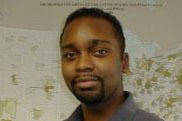Darryl Cohen
Geographer, Population Division, U.S. Census Bureau

Darryl Cohen is a Geographer in the Population Division of the U.S. Census Bureau, where he has worked since 1998. He has worked on reviewing and revising the federal Office of Management and Budget (OMB) standards for defining metropolitan areas. He also works on maintaining the geographic base for the Census Bureau’s intercensal population estimates. In addition, Darryl helps design and maintain various metropolitan and micropolitan statistical area data products, including Census 2000, and post-censal population estimates table packages, and various definition and geographic relationship files publicly available on the Census Bureau’s website. Frequently, he responds to inquiries from the media, congress, other government agencies, and the general public.
Darryl’s research on settlement classification, census geography, and population data has been published in journals and government reports, and serve as the subject for numerous conference presentations. He holds a master’s and a bachelor’s degree in Geography with concentrations in Urban Planning from the University of North Carolina at Greensboro, as well as a bachelor’s degree in Philosophy. In 2001, Darryl received the Department of Commerce Bronze Medal Award as a member of the metropolitan area standards review team. He currently lives in Upper Marlboro, Maryland.
This profile was published in 2004. Darryl is currently still a geographer in the Population Division of the U.S. Census Bureau.
AAG: Did you always know you wanted to be a geographer?
Darryl: No, actually I found geography almost by accident. My original intention was to become an urban planner. I have always been fascinated by cities, which probably stems from having grown up in the District of Columbia, and learning about the L’Enfant plan and how the city was laid out. Finding the right undergraduate program was a bit of a journey for me, but in the end I was fortunate enough to find an urban planning concentration in the geography program at UNCG.
AAG: And now you have the rare job title of Geographer. How does that feel?
Darryl: It’s not as important to me as the fact that I enjoy what I’m doing. It doesn’t really matter what’s on my business card, as long as my work is intellectually stimulating and I’m contributing something valuable.
AAG: Well said.
Darryl: I think the variety of job titles among geography professionals speaks to the nature of our discipline. There are so many different opportunities and areas of specialization that often your job title is not going to be geographer. Even here at the Census Bureau, there are a lot of people who have degrees in geography, but do not have the job title of geographer; they are statisticians, or cartographers, or social science analysts. There are a lot of different jobs for which people with degrees in geography are qualified.
AAG: What is your favorite part of your job?
Darryl: Probably the research. Discussing — from a conceptual standpoint — what constitutes a metropolitan area and how the areas should be defined.
AAG: What kinds of discussions come up?
Darryl: One fascinating thing . . . is taking a look back at research done previously and finding that many of the same issues come up over and over again. Say, 50 years ago they were having some of the same discussions that we are having today regarding determining the extent of metropolitan boundaries, what measures of integration to use, how to assign titles . . . all those things have been addressed by various people here at the Census Bureau and other agencies since the 1940s. That’s something that I’m working on – a history of the development of the standards for defining metropolitan areas.
AAG: What major new research potential do you see on the future horizon?
Darryl: Well, one is certainly on the micropolitan statistical areas, since OMB has only been defining them since 2003. We only have 4-5 years of data using those definitions, so that’s an area that’s certainly becoming ripe for research.
AAG: What do you see about your work that is important for others?
Darryl: It is important that the definitions add value to our data products – and that they are as good as they can be – because so many people depend on the data for various levels of decision-making, whether it’s setting policy at the federal level, state or local government planning, location analysis in the private sector, academic research, and so on.
AAG: Do you get to make it to the AAG Annual Meeting every year?
Darryl: Usually, yes. The Census Bureau is very supportive of our participation in professional associations and conferences.
AAG: Why do you most like to go?
Darryl: Mainly to build contacts with people, particularly people I may not know personally, but I may share a research interest with them. Over time, you develop a professional relationship with folks and look forward to seeing them year to year.
AAG: Why is that important?
Darryl: Part of the reason why we try to remain active in the AAG and participate in meetings is that our work is and should be done in an open manner – not only do we want to share what we are doing, but we also want to learn about how people are using the data that we publish.
AAG: What do you think would inspire more young people to do geography like you?
Darryl: Looking at how geography has grown in leaps and bounds, I think they are already inspired. That may be in part because we live in an increasingly global society, and it’s more important now to have information about places that aren’t necessarily close to where you live. Since so much information from different parts of the world is so readily available, geography has become more important now than ever. And . . . it can be a very fulfilling career choice.
Dr. Patricia Solis, 2004